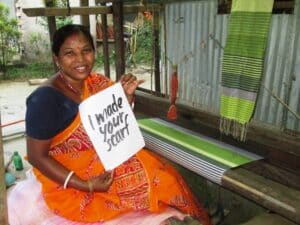What We Wear Matters
Every morning we get up and put on some clothes, often wondering which outfit will help us to better handle the day ahead; which color, which style will give us that extra boost to greet the day with more energy and confidence? But how often do we think about who made our clothes, and what their daily lives are like?
We often relate with our clothes as an appendage of ourselves, a fashion statement, a reflection of our mood, or a remedy to enhance our mood. If we look deeper, we see that our clothes are really a reflection of the choices we make. Like the food we eat, our choices have consequences, and directly impact us as well as the people and environment that have gone into creating that item we have chosen. When we examine this more closely, most of us find that very few garments in our wardrobe are ethically produced, and we have absolutely no idea about who made them, and all the steps along the way.
The clothes and accessories we wear are the end result of many hands that have gone into creating them. From the farmers and farm workers who grow and harvest the cotton, to those who spin, dye, and weave the yarn, to those who stitch the fabric, each garment is the result of many people who have worked for many hours. The question is, were they paid well for their labors? Is the true value of their labor, plus the environmental impacts, reflected in the actual cost of the garment? What percentage of that cost actually goes to the people who have made it?
The vast majority of commercially produced clothing is made in developing countries where garment workers earn very low wages. According to a Public Radio International (PRI) 2017 report, garment workers earn much less than the national wage average in most countries of the world. In china, garment workers earn just 20% of the national wage average, and in countries like Bangladesh where the national average wages are already very low, garment workers earn 65% of the national average. In the United States, garment workers earn 51% of the national average. It is all relative to the economic conditions of each country, but across the board, garment workers remain one of the most underpaid sectors of every society.
It is estimated that around 75 million people around the world work to produce the clothes that we wear, and around 80% of these garment workers are women. The majority of these garment workers live in poverty; despite working long hours, often in unsafe and unhealthy working conditions, they cannot afford basic necessities such as adequate food, shelter, and health care.
Much like the food industry, the clothing industry has become one of fast, disposable fashion. Things are cheap and we consume more and dispose of more on a regular basis. It is estimated that we consume 400% more clothing now than we did 20 years ago, and this ultimately means more waste in our landfills, more depletion of water resources, and more pollution of our land and water from the chemicals and dyes used in manufacturing the clothes we wear.
It’s time for us to be conscious consumers, mindful of what we put in our bodies and what we wear on our bodies. Wearing ethically produced clothing and accessories makes a difference to our health and the health of workers and the planet, just like how eating fresh, organic foods does. Choosing clothing that is made with natural fibers and either natural or low impact dyes, is better for our bodies; our skin can breathe in natural fibers and our body temperature can regulate itself more naturally. Plus it just feels better to put on something that was made without exploitation of people and our planet’s resources. There is value in the garment that cannot even be measured, it has an inherent integrity, as it was made with respect and care for people and the earth.
A garment or scarf that was made by hand by an artisan has even more value, as that artisan is practicing the craft of their ancestors, and is able to maintain a quality life in their village, rather than migrating to urban slum areas to work in factories. Each piece is a work of art, and reflects a deep knowledge base that is vital for the health of our society and our planet. The cultures that nurture and sustain crafts such as handloom, hand block-printing, and hand-embroidery have much wisdom to bestow, if only we can take the time to appreciate what they know, and to listen.
Sevya’s ethical apparel collection includes fair trade clothing, hand-woven scarves, and handmade jewelry. We are honored to work with the artisan groups in India who make these beautiful products. We learn from them how to slow down and nurture what is valuable in our lives and in the world. What we wear matters, in very profound ways.
Meet Aabha, one of the women who weaves our scarves and the material for our garments. She is proud of her culture and her work, and artisans like her are an integral part of the Fair Trade Fashion Revolution


